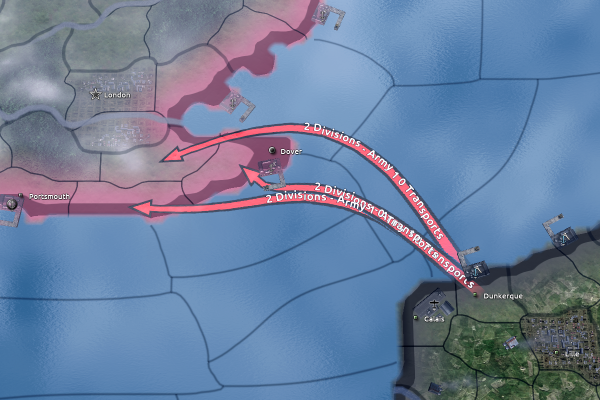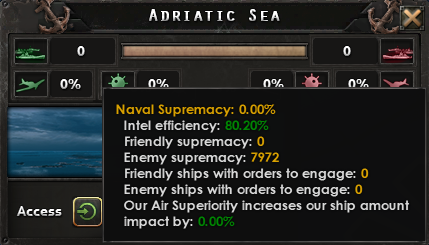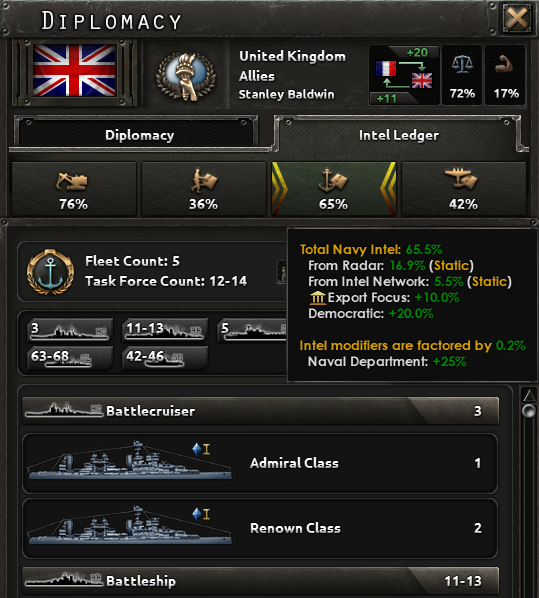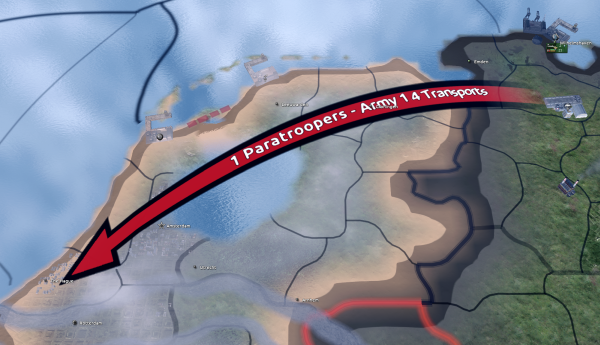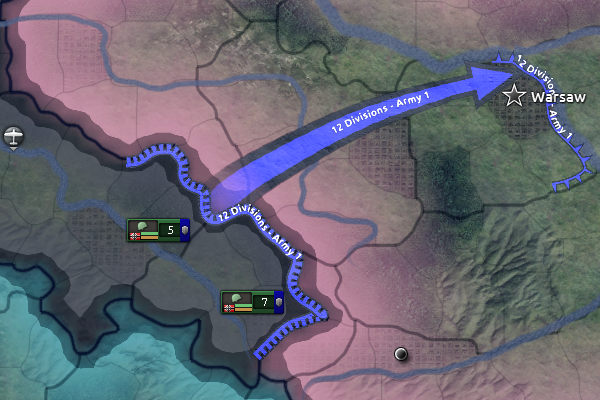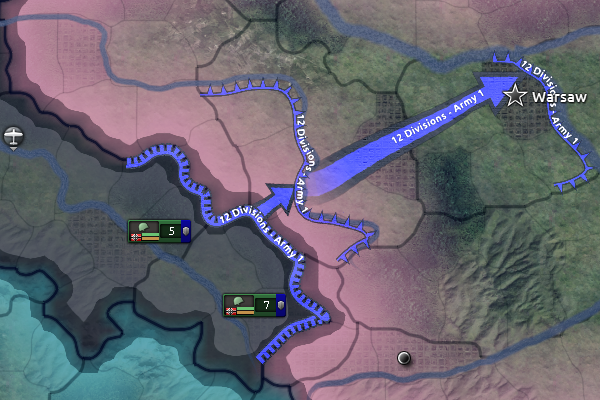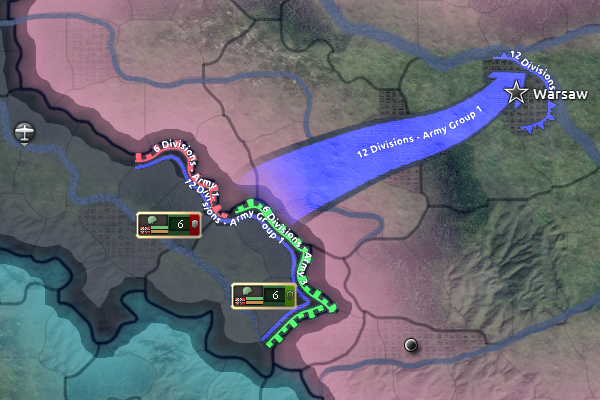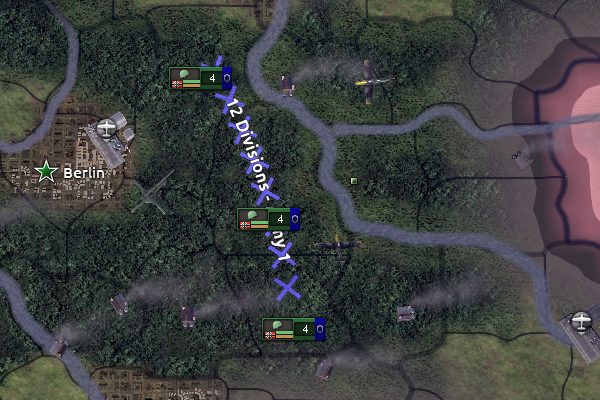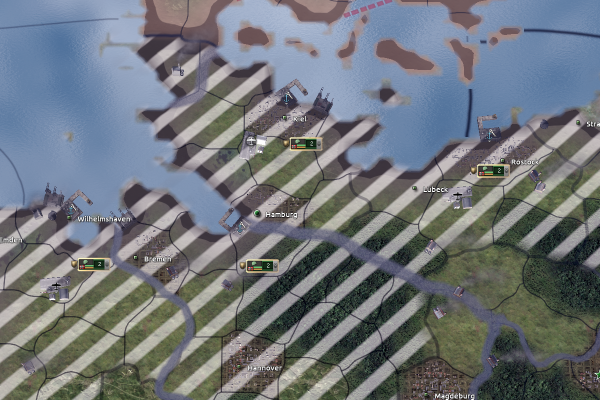作战计划 是一種能帮助玩家看到他们的部队会如何前进攻重要的工具, 可以让AI控制玩家的部队并授予其计划加成操纵部队并不一定要用计划来执行,但使用它能帮助玩家减少微操以及增加游戏流畅性。
如果有需要的话, 在一个集团军内的不同部队可以被分配至不同的作战计划. 在这種情况下,玩家将需要手动把部队分配至各作战计划中, 否则部队将会被规划到第一条划出的计划。
举个例子,如果你要大举入侵意大利的话,你可以在对方忙于在南方作战时的空档创造一个由北部攻击的作战计划,作战的目的是联合南方的军队摧毁敌方军队。玩家可以设置并在合适的时候分批激活一个或更多的登陆/空降以及陆军攻击计划。一些计划也许是计划被同时激活,也可能分批连续激活。 如果要激活特定的计划,只需SHIFT+左键点击该计划就能激活。玩家也能在计划激活前或激活后改变该计划的性质,玩家可以借此吧集团军内不同部分的部队分配到不同的任务中以配合整体计划,就像在二战中不同的陆军军队执行不同的任务一样。你可以选择不用这些功能,但在某些你要同时或分批激活的时刻这些功能是很有用的。
如果玩家要創建陸軍的進攻計劃,首先要創建一條前綫-這是陸軍開始執行計劃的地方。選擇'前綫'安鈕(或者Z鍵),然后再你和對方的國境綫/戰鬥區域上畫一條綫,這條綫代表了你選擇的部隊集結的地方。最后按下'進攻綫'按鈕'(或者X鍵)(圖想是一個箭頭)然后畫一條指示陸軍該由此處往何處進攻的綫。
Drawing battle plans
|
|
这部分内容可能已不适合当前版本,最后更新于1.9。 |
The battle plan tools can be accessed via the battle plan toolbar that opens when an army (a general) or an army group (a field marshal) is selected.
For the buttons
see the article Hotkeys#Battleplan_hotkeys.
With the button
the player can select if the battle plan is executed ![]() carefully, in
carefully, in ![]() a balanced manner or
a balanced manner or ![]() aggressively.
aggressively.
The use of the buttons
is described in the following sections.
![]() A naval invasion is an amphibious attack on enemy territory. It is a very powerful tool to open up new fronts against an enemy where he least expects them.
A naval invasion is an amphibious attack on enemy territory. It is a very powerful tool to open up new fronts against an enemy where he least expects them.
When selecting a naval invasion order, the player will be asked to left-click on a province with naval base as point of departure. There the army will gather for the assault. And right-click on the enemy province(s) to invade.
Naval invasions may be launched from any friendly port that the player has access to. This means that an invasion can be launched on enemy territory from the port of an ally that is not at war with the enemy.
Capacity
The total number of divisions assigned to naval invasions of a country is limited by its ![]() Naval Invasion Capacity. The capacity is determined by the naval technologies of the 'transports' branch. The base value is zero, which means that the technology “Transport Ship” must be researched before divisions may be assigned to a naval invasion.
Naval Invasion Capacity. The capacity is determined by the naval technologies of the 'transports' branch. The base value is zero, which means that the technology “Transport Ship” must be researched before divisions may be assigned to a naval invasion.
| Year | Technology | |
|---|---|---|
| 1922 | +10 | |
| 1940 | +40 | |
| 1944 | +100 |
The naval invasion order that has more divisions assigned than the Naval Invasion Capacity limits will not take place. The arrow on the map appears but with the text “No divisions 0 Transports”. The assigned divisions keep their ! red exclamation mark which indicates that they have no orders.
Country's invasion capacity is measured in division number, not in their total weight or combat width. Wider and more powerful division templates allow to execute stronger invasions.
Preparation time
Naval invasions require time to prepare before they may be executed. The exact time it will take is dependent on technology and the amount of divisions to be shipped over. With the first level of naval invasion technology, a 1-division invasion will take 7 days and 10-division invasion will take 70 days of planning. Landing Craft technology (1940) halves time required.
The planning will proceed immediately, even while the divisions are still on their way to the departure port.
It is possible to prepare several invasions from different ports in parallel, even to the same target province(s), saving on total preparation time. It is also possible to prepare several invasions to different target provinces from the same port.
Convoys
In order to ship units over to foreign lands, sufficient convoys are required to do so. The amount of convoys an individual division requires is dependent on its weight; the weight is equivalent with the amount of convoys require to ship over one division. The amount of convoys required is rounded up. Technology may decrease the amount of convoys required for an invasion.
| Weight | 0.1 | 0.5 | 0.7 | 1.0 | 1.2 | 1.5 | 1.7 |
|---|---|---|---|---|---|---|---|
| Battalion |
|
|
|
|
|
|
|
To be able to get naval supremacy, you have to have at least 30% naval intelligence efficiency.
The actual value of naval intel efficiency of a seazone can be seen in the seazone property window, that you get when you click a seazone. You have to hover with the mouse over the naval supremacy bar. Alternatively you can see it, when you hover with your mouse over a seazone in the strategic navy map mode (accessible with the F2 button).
The naval intel efficiency of a seazone is calculated from the intel you have from nations you are at war with and that have ships in that seazone. If you are not at war, you have 100% naval intel efficiency everywhere. If you are at war with one country, you have 100% naval intel efficiency in all seazones in which this country has no ships assigned (the value Enemy supremacy is 0). In the seazones in which the country has ships assigned (Enemy supremacy > 0), the naval intel efficiency is the intel you have of that country. If you are at war with more countries, and more than one of these countries have ships in one seazone, the naval intel efficiency, is weighted towards the country that has more naval supremacy in that seazone.
With the DLC ![]() La Résistance, the intel you have of a country, can be seen in the intel ledger of that country. When you hover with the mouse over the naval section of the intel ledger, you see how the navy intel is calculated.
La Résistance, the intel you have of a country, can be seen in the intel ledger of that country. When you hover with the mouse over the naval section of the intel ledger, you see how the navy intel is calculated.
There are several factors that contribute to naval intel efficiency. The naval intel efficiency against a specific enemy country, expressed as a percentage between 0 and 100, is the sum of each of the following factors:
Common factors on naval intel efficiency: (With and without La Résistance)
- Enemy Ideology (Democratic: 20%, Non aligned: 20%, Communist: 12.5%, Fascist: 10%)
- Enemy Trade law (Free trade: 20%, Export focus: 10%, Limited exports: 5%, Closed economy: 0%)
- Radar coverage (Radars that cover any seazone with enemy ships on missions, can provide up to 20% naval intel efficiency. Naval intel gathered per radar is only one value per country, not per seazone. Naval intel about the UK gathered per radar that covers the english channel can provide naval intel efficiency for a naval invasion in the Mediterranean Sea.)
- Fighting the enemy navy (Naval intel gained from naval battles decays by around -0.2%/week.)
Factors on naval intel efficiency only with the DLC ![]() La Résistance:
La Résistance:
- Spy networks (up to 40%)
- Operations (Infiltrate navy 10%)
- Decrypted enemy ciphers (passive bonus 10% and 30 days bonus 50%)
- Intel from faction members (30% of the intel difference)
- Captured enemy operatives.
The Naval Department upgrade to Intelligence agency boosts the naval intel efficiency by +25% of its total value, i.e. it is multiplied by 1.25.
Factors on naval intel efficiency only without the DLC La Résistance:
- Own Decryption level and enemy Encryption level
Own Decryption level 0 1 2 3 Enemy Encryption level 0 0% 30% 45% 60% 1 0% 15% 22.5% 30% 2 0% 10% 15% 20% 3 0% 7.5% 11.25% 15%
Example with the DLC ![]() La Résistance:
La Résistance:
As illustrated by the picture opposite: Democratic ideology (20%), Export Focus trade law (10%), Radar coverage (16.9%) and Spy network (5.5%) adding up to 52.4%, then multiplied by 1.25 from the Naval Department, give the total naval intel efficiency of 65.5% against this particular instance of UK.
Example without the DLC La Résistance:
If you don't use the DLC La Résistance and want to naval invade a fascist country (10%) that has closed economy (0%) and has researched Encryption level 3 and you have Decryption Level 3 (15%) and have no radars that cover any enemy territory: You get a naval intel efficiency of 25% and need to fight their navy to be able to get over the needed 30% naval intel efficiency.
Strategies if it's not possible to get 30% naval intel efficiency:
If there is nothing that contributes to naval supremacy in a seazone (Enemy supremacy is 0), you get naval intel efficiency 100%. A strategy is to finish planning of a naval invasion, send your ships out to get naval supremacy and start the invasion, even if you do not have enough naval intel efficiency. If the enemy is changing orders of fleets you might get 100% naval intel efficiency for a moment. That short moment is sufficient to start the naval invasion.
|
|
这部分内容可能已不适合当前版本,最后更新于1.9。 |
To execute a naval invasion, a country requires more than 50% naval supremacy (also called 'naval superiority' in some tooltips) in all strategic regions (sea zones) in which the divisions will need to traverse the sea en-route to their destination. These are the regions the arrow of the naval invasion battle plan passes through.
To be able to get naval supremacy, you have to have at least 30% naval intel efficiency.
Naval supremacy of a navy depends on what type of mission it is running, how effective it is on the region, how many ships it has and how large they are. Naval supremacy in a strategic region (sea zone) is the sum of naval supremacy of the taskforces assigned to it.
Naval supremacy by naval missions: [1]
| Mission | Naval supremacy |
|---|---|
| 100% | |
| 100% | |
| 100% | |
| 50% | |
| 50% | |
| 30% | |
| 30% | |
| 0% | |
| 0% |
Larger ships contribute more to naval supremacy. For example the italian early battleship RN Andrea Doria provides 356 naval supremacy on strike force mission. A single Curatone Class italian early destroyer provides 117 naval supremacy on strike force mission. Naval supremacy per ship is calculated as:
- Naval supremacy of ship = 100.0 + 0.005 * ship production cost in industrial capacity (IC) + 0.05 * ship manpower
Task forces with Do Not Engage order do not contribute to naval supremacy.
Air superiority and Minelaying provide a bonus for naval supremacy. Maximum possible bonus from air superiority is +100% to the ship amount, making each ship count for two. It is achieved when air superiority is 100% and there are enough planes to cover 100% of the sea region.
Naval supremacy is only required for a short moment to launch the prepared invasion. After that the invasion will proceed even without sufficient supremacy. Once the naval invasion has been properly planned, naval supremacy and naval intel efficiency has been attained, and sufficient convoys are gathered, the plan may be activated.
Invasion in transit
Invading divisions travel through the sea province by province on convoys, and can be intercepted by enemy fleets and bombers just like supply and trade convoys. It is recommended to use escorts for the convoys, lest the enemy rally their entire fleet to intercept the invading fleet.
When invaders reach the shores and begin to disembark, the side being invaded gets a notification with an icon and a sound and has a brief moment to rally any defenders.
Invasion speed is improved by technology, and is greatly delayed by attacks on the convoys.
Invasion combat
If there are any defenders in the province where the invaders try to land, a land combat starts. As the troops land they need to unload from the ships first and this leaves them vulnerable to enemy fire, so they receive a hefty malus. Marines are special forces troops specifically trained for amphibious assaults, and receive a large bonus to compensate amphibious landing penalty.
Consider using Shore bombardment to support the invasion, as well as any close air support in range.
Post invasion
Unless invading divisions have captured a port or a city, they might be cut off from supply, and need to achieve these objectives within 72 hours before supplies run out.
Paradrop
![]() A paradrop is an attack by air on enemy territory. A paradrop may only be executed by paratroopers and their support equipment. Divisions with any battalions that cannot be dropped may not be used in a paradrop. Most kinds of line battalions will make a division ineligible for air drops if they are present in the division; see the division designer display on whether the division is para-capable.
A paradrop is an attack by air on enemy territory. A paradrop may only be executed by paratroopers and their support equipment. Divisions with any battalions that cannot be dropped may not be used in a paradrop. Most kinds of line battalions will make a division ineligible for air drops if they are present in the division; see the division designer display on whether the division is para-capable.
A paradrop must start from an airfield with transport planes. Make sure that the number of transport planes is equal to or greater then the weight of the paratroopers. You must have 70% control of all air zones from the airfield to the drop location. If the airfield has planes over the capacity of the airfield the mission will not launch.
As there is aerial supply system in HOI4, a supply source, such as a large city, a port or a connection to the main front should be established as soon as possible in order to avoid the effects of being unsupplied. It is advisable to land paratroopers in an area near a supply source and to quickly assault that source, as supply sources tend to be well guarded. it is also great to use the new aerial supply system from waking the tiger DLC as it will allow paratroops to fight for long and hold the line against the enemy. Dropping atop enemy troops is an attack with hefty penalties and certain destruction if defeated unless the paratroops can retreat to adjacent friendly-controlled territory.
If experiencing problems with paradrops even when you have air superiority in the target zone, there may be another problem. If your target province lies within an air zone whose central node is outside the range of your transport planes, then it can cause an infinite delay and prevent paradrops. What this means is that, in a number of airfields, provinces might technically be in range of your transport planes, but your planes will never arrive at those provinces, because the target air zone's coverage node is outside of their range (or something like that). The Germany-to-Southern-England thing is a particularly obnoxious example, but it happens in a lot of other places too (the Pacific and South America, for example).
Fortunately, you can get around this broken game mechanic by, well, breaking it further. When your para drop order appears on the Air map screen (same place where you assign Air Superiority and Ground Support missions), left-click the order's circular icon (probably looks blank), then right-click reassign your order to an air zone whose central node is closer to your airfield (this will usually, but not always, be the air zone your airfield is located in).
The AI never attempts paradrops.
Air superiority
A paradrop, like a naval invasion, requires at least 70% air superiority in the strategic area the target belongs to. Air superiority is primarily attained by directing fighters to secure air superiority in a region, but (non-naval) bombing and close air support may help as well.
Transport planes
As with convoys for naval invasions, paradrop orders require transport planes in order to be executed. Contrary to other planes in the game, 1 transport plane does not represent 1 plane but rather a group of planes required to transport units.
The amount of transport planes required depends on the weight of the divisions to be transported. Paratroopers battalions weigh 0.5 and paratroop support companies 0.1. One transport plane has a carrying capacity of 2.0, and so could carry a division of 4 para battalions, or 3 para battalions with several support companies. If the air drop order planes total too little carrying capacity for the paratroops assigned, the transports will make several trips to ferry the paratroops, exposing them to more enemy attacks and causing the troops to arrive in separate waves.
Divisions need to be in a province with an airfield with transport planes in order to be able to execute the paradrop.
Front line and offensive line
![]() A Front Line is the starting point of attacks into enemy territory. A player can either assign a whole country's border as a front line by clicking on the border or a player can assign a part of a country's border as a front line by holding the right mouse button and dragging the mouse over the provinces the player wants to belong to the front line deployment area. The AI will then move all the divisions into the position that the commander assigns to that front line. They are assigned either by having them selected when the front line button is clicked or added later by selecting them and Control-Clicking on that line. A player can also create several unconnected front lines and assign divisions between them, which may be particularly useful for a field marshal who may command an unlimited amount of divisions conducting various operations in different locations around the world. Divisions that are stationed at a front line that borders a non-ally will receive a planning bonus for their pre-attack preparation time. Front lines can only be positioned at a border, and the front line of battle between opposing forces counts as a border for this purpose.
A Front Line is the starting point of attacks into enemy territory. A player can either assign a whole country's border as a front line by clicking on the border or a player can assign a part of a country's border as a front line by holding the right mouse button and dragging the mouse over the provinces the player wants to belong to the front line deployment area. The AI will then move all the divisions into the position that the commander assigns to that front line. They are assigned either by having them selected when the front line button is clicked or added later by selecting them and Control-Clicking on that line. A player can also create several unconnected front lines and assign divisions between them, which may be particularly useful for a field marshal who may command an unlimited amount of divisions conducting various operations in different locations around the world. Divisions that are stationed at a front line that borders a non-ally will receive a planning bonus for their pre-attack preparation time. Front lines can only be positioned at a border, and the front line of battle between opposing forces counts as a border for this purpose.
![]() An Offensive Line is a line that a player draws through enemy provinces that contain objectives for the assigned army units to move to and capture. From a front line, or from another offensive line, a player can draw one or several offensive lines or arrows that tell the AI how the player wants the selected plan's divisions to advance from the front line. The width and arc of the offensive line can be adjusted as described on the tooltip. If the mouse cursor is dragged over the offensive line or arrow the game will show the exact visualisation of how the AI will advance the divisions, step for step. ALT for edit mode and TAB to shift the arrow's base can be useful to direct the main effort.
An Offensive Line is a line that a player draws through enemy provinces that contain objectives for the assigned army units to move to and capture. From a front line, or from another offensive line, a player can draw one or several offensive lines or arrows that tell the AI how the player wants the selected plan's divisions to advance from the front line. The width and arc of the offensive line can be adjusted as described on the tooltip. If the mouse cursor is dragged over the offensive line or arrow the game will show the exact visualisation of how the AI will advance the divisions, step for step. ALT for edit mode and TAB to shift the arrow's base can be useful to direct the main effort.
![]() The order to execute battle plans is given with the button above the commander portrait, along with a tooltip that provides information and advice from the staff regarding the battle plan. The AI then executes the battle plan until the troops reach their offensive line which has then become the new front line. If that front line has offensive line orders beyond it then the execute button has to be pressed again to resume the advance from the new front line. Pausing to rest, resupply, refit, regroup, and coordinate further plans was common between phases of a major offensive. This is also a good time to detach troops to consolidate control over occupied territory, which usually involves smaller divisions that specialize in discouraging unrest. The Garrison Area battle plan order is one used in such a situation.
The order to execute battle plans is given with the button above the commander portrait, along with a tooltip that provides information and advice from the staff regarding the battle plan. The AI then executes the battle plan until the troops reach their offensive line which has then become the new front line. If that front line has offensive line orders beyond it then the execute button has to be pressed again to resume the advance from the new front line. Pausing to rest, resupply, refit, regroup, and coordinate further plans was common between phases of a major offensive. This is also a good time to detach troops to consolidate control over occupied territory, which usually involves smaller divisions that specialize in discouraging unrest. The Garrison Area battle plan order is one used in such a situation.
More examples for front line and offensive line
More examples for front line and offensive line

Spearhead
|
|
只适用于DLC共赴胜利激活时。 |
![]() The spearhead order starts from a front line and can be used alongside or instead of the Offensive Line within an army. Unlike the normal battle plan that spreads out to cover its flanks and adjusts to circumstances, spearheads advance in a narrow path one province wide to their objective, exactly as it was when first defined. This makes them suitable for blitzkrieg-style armored penetrations that can capture a specific goal or work with another spearhead pincer to encircle enemy cities or armies in pockets, sealed in a ring of steel by the mobile and regular infantry divisions following behind. Encircled armies can thus be annihilated, as routed divisions which lack friendly territory to retreat to are destroyed.
The spearhead order starts from a front line and can be used alongside or instead of the Offensive Line within an army. Unlike the normal battle plan that spreads out to cover its flanks and adjusts to circumstances, spearheads advance in a narrow path one province wide to their objective, exactly as it was when first defined. This makes them suitable for blitzkrieg-style armored penetrations that can capture a specific goal or work with another spearhead pincer to encircle enemy cities or armies in pockets, sealed in a ring of steel by the mobile and regular infantry divisions following behind. Encircled armies can thus be annihilated, as routed divisions which lack friendly territory to retreat to are destroyed.
Spearhead (shortcut 'SHIFT + X') may be used only through territory past the attacking army's front line or territory assigned to a naval invasion (tanks rolling off the landing craft into battle). Spearheads follow the exact paths traced on the map by right-clicking and dragging the mouse through successive provinces. This may enable the attacking forces to plan a path that bypasses forts, cities, or other undesirable terrain in order to maintain their momentum.
Fallback line
![]() The player can draw fallback lines in controlled territory, and that will tell the AI upon order execution to move and deploy its divisions behind the fallback line in the same manner as with a front line, hold the line against enemy assaults, and counter-attack to restore the position if the line is broken. Unlike front lines, divisions stationed at fallback lines do not receive a planning bonus; however, divisions that are stationed a long time in a province can accumulate an entrenchment bonus while remaining in that position.
The player can draw fallback lines in controlled territory, and that will tell the AI upon order execution to move and deploy its divisions behind the fallback line in the same manner as with a front line, hold the line against enemy assaults, and counter-attack to restore the position if the line is broken. Unlike front lines, divisions stationed at fallback lines do not receive a planning bonus; however, divisions that are stationed a long time in a province can accumulate an entrenchment bonus while remaining in that position.
Defense area
![]() Defense Area assigns the entire army to guard an area rather than a front line. It is mainly useful for divisions on antipartisan duties or to protect against paratroopers. As the divisions are spread out over one or more states rather than concentrated in a position for defense, this posture is ill-suited near the front line. If part of the area is lost to the enemy, then the garrison units will automatically attempt to recover the lost territory.
Defense Area assigns the entire army to guard an area rather than a front line. It is mainly useful for divisions on antipartisan duties or to protect against paratroopers. As the divisions are spread out over one or more states rather than concentrated in a position for defense, this posture is ill-suited near the front line. If part of the area is lost to the enemy, then the garrison units will automatically attempt to recover the lost territory.
The defense command has multiple subsections (see graphic):
- Protect Victory Points
- Guard Ports
- Guard Coast
- Protect Airbases
- Attempt to Lower Resistance
- Guard Forts
The player can choose which of these he wishes to guard and the UI will tell the player how many divisions the AI considers necessary to satisfy the command. The garrison area order triples the limit of units under a commander to 72 without incurring a debuff. Reducing resistance is best accomplished with an army of security divisions. 2-6 Cavalry battalions plus Military Police make effective security divisions, and require only minimum weapons and training.
A very different type of garrison division is a static division intended for positional defense - its purpose is not to do damage but to entrench and hold as long as possible against enemy attack to provide time for relief to arrive. ORG, DEF, and entrenchment are important, as is piercing enemy armor. This division can be trained infantry with basic weapons, Engineers for defense, and a battalion or company of AA guns (which help against air attack, can pierce light armor, and don't need tungsten to make) or AT guns. It will be fighting alone, so combat width is not important.
Planning bonus
|
|
这部分内容可能已不适合当前版本,最后更新于1.9。 |
When a division is at the starting position of an offensive battle plan (i.e. a battle plan containing at least one Offensive Line or Spearhead order) and is neither moving or fighting, it will accumulate a planning bonus at the start of each day, expressed as a percentage, until a maximum planning bonus is reached. This confers greater combat performance for the division.
The max planning bonus for each division (initially capped at 30%), or the rate of daily planning bonus accumulation, can be increased by certain Land doctrine choices and National Spirits. The base daily gain is 2%, so it will take e.g. 15 days to accumulate to the 30% cap. Using a general will also add both to the max planning bonus and the rate of daily planning bonus accumulation. Each point of a general's planning rating will contribute +2% of max planning bonus, and +5% to the daily planning bonus accumulation. However, the +5% to the daily planning bonus is multiplicative to the 2% daily base rate. So for example, when using a general with a planning rating of 4, he will add +8% to the max planning bonus (so 30% + 8% = 38%, assuming no other bonuses), and the daily planning bonus accumulation will be 2.4% (2% * (1 + (4 * 5% = 20%)) = 2.4%). Continuing the example, it will now take 16 days to complete the full planning bonus (38% / 2.4% = 15.8 days).
When a division with a planning bonus is moving or fighting, it will lose some of its planning bonus each day. The planning bonus for a division will decay slowly if the division is being automatically managed by the battle plan AI. If a division is manually commanded by the human player, the planning bonus will decay at a considerably faster rate.
Strategy
Since achieving the maximum planning bonus will take a number of days, it may be worthwhile to prepare battle plans during peacetime, so that each division will have a full planning bonus upon the outbreak of war.
If the player wishes to minimise the rate of planning bonus decay, it may be helpful to prepare a complex battle plan containing multiple orders. This can enable divisions to achieve their objectives without requiring manual commands from the player.[2]
Alternatively, the human player can micromanage their divisions, to achieve finer control or the ability to react to changing circumstances. This presents a tradeoff, as planning bonus will be lost more quickly when manual commands are issued.
Manual control and battle plan; support attack
Divisions that belong to a battle plan and receive a manual order will revert back to AI control after implementing the order.
Once combat is joined, the player may select an unengaged division and then Ctrl+right click (or Ctrl+alt+right click) on the combat icon to make the selected division join in a support attack. This allows the division to assist in the attack without automatically advancing the division into the enemy-occupied area upon victory. The battle plan AI may automatically order such a support attack, as well.
Battle plan and allies
Players can see their allies' battle plans (an option that can be toggled on and off in the lower right corner of the screen). This may help in multiplayer to coordinate with allies and in single player to understand what the AI is doing because AI countries create their own battle plans.
| 政策 | 意识形态 • 阵营 • 国策 • 内阁 • 政府 • 傀儡国 • 外交 • 全球紧张度 • 内战 • 占领区 • 情报机构 |
| 生产 | 贸易 • 生产 • 建设 • 装备 • 燃料 |
| 科研与科技 | 科研 • 步兵科技 • 辅助部队(支援连)科技 • 装甲车辆科技 • 火炮科技 • 陆军学说 • 海军科技 • 海军学说 • 空军科技 • 空军学说 • 工程学科技 • 工业科技 |
| 军事与战争 | 战争 • 陆军单位 • 陆战 • 编制设计 • Army planner • 集团军 • 指挥官 • 作战计划 • 战术 • 海军单位 • 海战 • 空军单位 • 空战 • 经验 • 损耗与事故 • 后勤 • 人力 • 核弹 |
| 地图 | 地图 • 省份 • 地形 • 气候 • 地区 |
| 事件与决议 | 事件 • 决议 |
hoi4de:Battle plan hoi4es:Battle plan hoi4fr:Battle plan hoi4pl:Battle plan hoi4pt:Battle plan hoi4ru:Battle plan
- ↑ Defines: NNavy.MISSION_SUPREMACY_RATIOS
- ↑ For an example of this, see Zwirbaum's battle plan tutorial on Youtube

